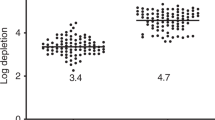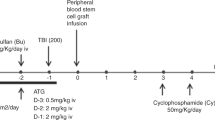Summary:
We mobilized peripheral blood stem cells (PBSC) following CHOP plus rituximab (CHOP-R) therapy, and compared with the findings following CHOP therapy without rituximab. All patients were given G-CSF starting from day 11 after CHOP therapy. Patients in the CHOP-R group (n=8) were given rituximab on day 12. Target CD34+ cells number was collected in a single leukapheresis on day 14, from all the eight patients in the CHOP-R group. PBSC mobilization kinetics, CD34+ cells yield and colony-forming ability in the graft collection, toxicity during mobilization, and engraftment after transplantation of CHOP-R group were not significantly different from those in the CHOP group (n=8). In all patients given CHOP-R therapy, CD20+ cells and immunoglobulin heavy chain (IgH) rearrangement in the graft collection were undetectable by flow-cytometric analysis and Southern blot analysis, respectively, but with PCR analysis two of eight grafts were positive for IgH rearrangement. While further studies are needed to evaluate the efficacy of purging and the outcome of patients undergoing autologous transplantation, CHOP-R therapy can be safely and effectively used in the mobilization phase of PBSC collection, without excess clinical toxicity or deleterious effect on PBSC mobilization kinetics or engraftment time.
This is a preview of subscription content, access via your institution
Access options
Subscribe to this journal
Receive 12 print issues and online access
$259.00 per year
only $21.58 per issue
Buy this article
- Purchase on Springer Link
- Instant access to full article PDF
Prices may be subject to local taxes which are calculated during checkout
Similar content being viewed by others
References
Shipp MA, Abeloff MD, Antman KH et al. International consensus on high-dose therapy with hematopoietic stem cell transplantation in aggressive non-Hodgkin’s lymphomas: report of the jury. J Clin Oncol 1999; 17: 423–429.
Horning SJ . High-dose therapy and transplantation for low-grade lymphoma. Hematol Oncol Clin North Am 1997; 11: 919–935.
Gribben JG, Neuberg D, Freedman AS et al. Detection by polymerase chain reaction of residual cells with the bcl-2 translocation is associated with increased risk of relapse after autologous bone marrow transplantation for B-cell lymphoma. Blood 1993; 81: 3449–3457.
Freedman AS, Gribben JG, Neuberg D et al. High dose therapy and autologous bone marrow transplantation in patients with follicular lymphoma during first remission. Blood 1996; 88: 2780–2786.
Gribben JG, Freedman AS, Neuberg D et al. Immunologic purging of marrow assessed by PCR before autologous bone marrow transplantation for B-cell lymphoma. N Engl J Med 1991; 325: 1525–1533.
McQuaker IG, Haynes AP, Anderson S et al. Engraftment and molecular monitoring of CD34+ peripheral-blood stem-cell transplants for follicular lymphoma: a pilot study. J Clin Oncol 1997; 15: 2288–2295.
Maloney DG, Grillo-Lopez AJ, Bodkin DJ et al. IDEC-C2B8: results of phase I multiple-dose trial in patients with relapsed non-Hodgkin’s lymphoma. J Clin Oncol 1997; 15: 3266–3274.
Lazzarino M, Arcaini L, Bernasconi P et al. A sequence of immuno-chemotherapy with rituximab, mobilization of in vivo purged stem cells, high-dose chemotherapy and autotransplant is an effective and non-toxic treatment for advanced follicular and mantle cell lymphoma. Br J Haematol 2002; 116: 229–235.
Magni M, Di Nicola M, Devizzi L et al. Successful in vivo purging of CD34-containing peripheral blood harvests in mantle cell and indolent lymphoma: evidence for a role of both chemotherapy and rituximab infusion. Blood 2000; 96: 864–869.
Voso MT, Pantel G, Weis M et al. In vivo depletion of B cells using a combination of high-dose cytosine arabinoside/mitoxantrone and rituximab for autografting in patients with non-Hodgkin’s lymphoma. Br J Haematol 2000; 109: 729–735.
Flohr T, Hess G, Kolbe K et al. Rituximab in vivo purging is safe and effective in combination with CD34-positive selected autologous stem cell transplantation for salvage therapy in B-NHL. Bone Marrow Transplant 2002; 29: 769–775.
Fisher RI, Gaynor ER, Dahlberg S et al. Comparison of a standard regimen (CHOP) with three intensive chemotherapy regimens for advanced non-Hodgkin’s lymphoma. N Engl J Med 1993; 328: 1002–1006.
Coiffier B, Gisselbrecht C, Vose JM et al. Prognostic factors in aggressive malignant lymphomas: description and validation of a prognostic index that could identify patients requiring a more intensive therapy. The Groupe d'Etudes des Lymphomes Agressifs. J Clin Oncol 1991; 9: 211–219.
Sawada K, Sato N, Kohno M et al. Efficacy of delayed granulocyte colony-stimulating factor after full dose CHOP therapy in non-Hodgkin’s lymphoma: a pilot study for a leukocyte count oriented regimen. Leuk Lymphoma 1995; 20: 103–109.
Takano H, Sawada K, Sato N et al. Mobilization of peripheral blood progenitor cells following CHOP treatment combined with delayed granulocyte colony-stimulating factor administration in patients with non-Hodgkin’s lymphoma. Leuk Lymphoma 1996; 21: 473–478.
Sato N, Sawada K, Koizumi K et al. In vitro expansion of human peripheral blood CD34+ cells. Blood 1993; 82: 3600–3609.
Clarke BJ, Housman D . Characterization of an erythroid precursor cell of high proliferative capacity in normal human peripheral blood. Proc Natl Acad Sci USA 1977; 74: 1105–1109.
Tarumi T, Sawada K, Koizumi K et al. A pilot study of a response oriented chemotherapeutic regimen combined with autologous peripheral blood progenitor cell transplantation in aggressive non-Hodgkin’s lymphoma. Leuk Lymphoma 1999; 34: 361–371.
Buckstein R, Imrie K, Spaner D et al. Stem cell function and engraftment is not affected by ‘in vivo purging’ with rituximab for autologous stem cell treatment for patients with low-grade non-Hodgkin’s lymphoma. Semin Oncol 1999; 26: 115–122.
Friedman J, Lazarus HM, Koc ON . Autologous CD34+ enriched peripheral blood progenitor cell (PBPC) transplantation is associated with higher morbidity in patients with lymphoma when compared to unmanipulated PBPC transplantation. Bone Marrow Transplant 2000; 26: 831–836.
Acknowledgements
We thank I Sato for technical assistance.
Author information
Authors and Affiliations
Corresponding author
Rights and permissions
About this article
Cite this article
Endo, T., Sato, N., Mogi, Y. et al. Peripheral blood stem cell mobilization following CHOP plus rituximab therapy combined with G-CSF in patients with B-cell non-Hodgkin's lymphoma. Bone Marrow Transplant 33, 703–707 (2004). https://doi.org/10.1038/sj.bmt.1704413
Received:
Accepted:
Published:
Issue Date:
DOI: https://doi.org/10.1038/sj.bmt.1704413
Keywords
This article is cited by
-
Poor mobilization is an independent prognostic factor in patients with malignant lymphomas treated by peripheral blood stem cell transplantation
Bone Marrow Transplantation (2006)
-
The role of rituximab in autologous and allogeneic hematopoietic stem cell transplantation for non-Hodgkin’s lymphoma
Current Hematologic Malignancy Reports (2006)



